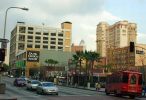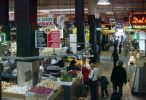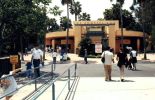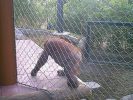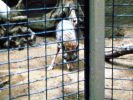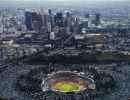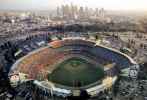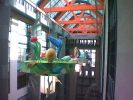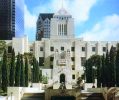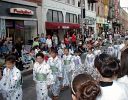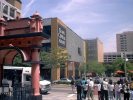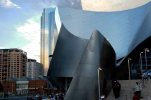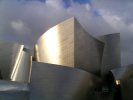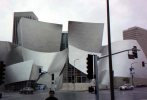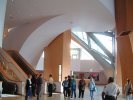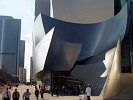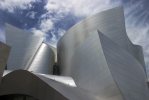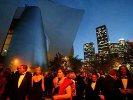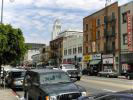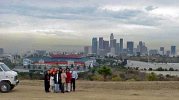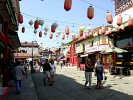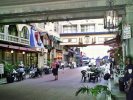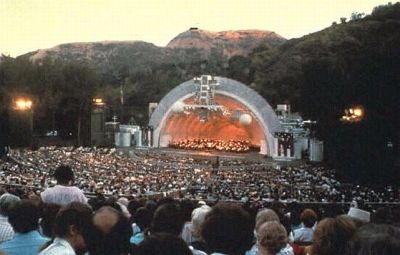 |
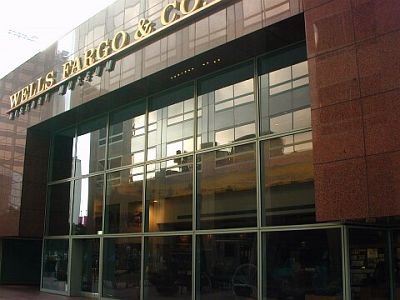 |
| Los Angeles Central Public Library (1926) was built by Bertram Grosvenor Goodhue in Byzantine, Egyptian Moderne, and Spanish architectural styles. In 1986 two fires gutted the library, destroying half a million books. Through the Save the Books campaign started by Mayor Tom Bradley and ARCO's Lodwrick M. Cook, eleven million dollars was raised to save and restore the library as well as the original Goodhue murals and decorations. An eight level library wing along with an auditorium and meeting rooms was added in 1993. This is the country's second biggest public library. Three blocks north along Flower Street from the Metro Center Station. |
| On July 11, 1922 conductor Alfred Hertz began the Hollywood Bowl's first season. The audience was seated on simple wooden benches placed on the hillside. The Bowl has been the summer home to the Los Angeles Philharmonic since 1922. Over the years the Bowl has been altered to improve the acoustics and seating capacity. In 1973 the reflecting pool in front of the stage was removed to allow for more seating. Today the Bowl can seat up to 18,000. As part of the Los Angeles park system, the Bowl is open free to the public all year round. Note: The hilly area behind the bowl's shell was where the TV show MASH was filmed. A few blocks north on Highland Avenue from the Hollywood/Highland Metro Rail subway station. |
| The Wells Fargo Western Museum is one of the best kept secrets in the Financial District. Explore our rich Western past as you view an original 1852 panoramic painting of Los Angeles or check out an actual Wells Fargo Concord coach. Walk thru a recreated gold agent's office and see the actual famous 100 ounce Challenge gold nugget. There's an authentic mine car on display along with tools of the trade including mining picks and shovels. You can easily spend a couple hours here looking thru the artifacts and displays. On the ground floor of the Wells Fargo Center twin towers at 333 South Grand Avenue. |
| Clifton's Cafeteria opened in 1935 and since then has become a favorite Los Angeles tradition and landmark. The interior of this three level cafeteria dubbed the Brookside has been created to resemble a redwood forest complete with waterfalls and babbling brooks. This is the world's largest public cafeteria, serving on average 1000 meals daily 7 days a week including holidays. On South Broadway north of West 7th Street. Website Clifton's Cafeteria |
| Historically refered to as Japanese Town or J-Town as long time residents call it, Little Tokyo is twelve city blocks of museums, shops, restaurants and residential buildings. This is also home to the world famous Asian theatrical group the East West Players. Places to visit here include the Japanese American National Museum, the roof top gardens at the New Otani hotel, the 16th century themed Japanese Village Plaza, the Temporary Contemporary Museum and the historic Far East Cafe which opened in 1935 and has been a favorite filming location for movies and TV. The best sushi is found here since many of Japan's top sushi chefs were brought here from Japan. Most sushi bars are open till 2 or 3 a.m. It is not uncommon to see Japanese business men enjoying freshly made sushi and cups of warm saki in the wee hours of the morning. Some of the events taking place during the year include the famous nine day Nisei Week, the Tofu Festival and every new years day pounding of sweet rice into Mochi along with stage entertainment. This is the largest of California's three Japan Towns. Four blocks south along First Street from the Civic Center Metro Rail subway station. |
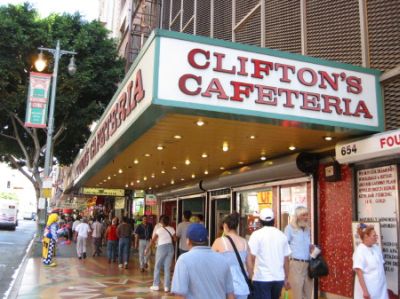 |
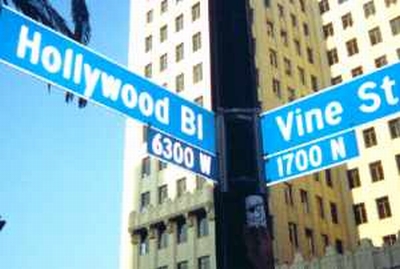 |
| Hollywood and Vine is the world's most famous intersection. During the movie industry's golden age it was common to see celebrities around here since most of the hot spots were located within this area. Live radio shows were done at the Vine St. Theatre (now the Dolittle), the Palace and the Pantages. Nearby restaurants and night clubs including the Brown Derby, Sardi's, the It Cafe, and Levy's Tavern were where the famous went to drink and dine. They also conducted their business in the Taft, B.H. DVAS (Broadway), Laemmle, and Equitable buildings that took up the four corners of this intersection. A half block west of the Hollywood/Vine Metro Rail subway station. |
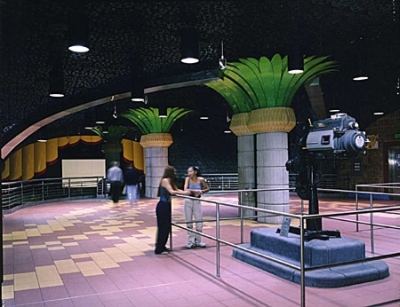 |
| Normally subway stations are not regarded as tourist attractions but this one is a must see so we just had to include the Hollywood/Vine Metro Rail station which is not your usual subway station. Entering this station from street level gives the impression of entering a movie palace from the golden age of motion pictures. Descending into the lower levels reveals a subway station designed in the movie theatre style that was popular in the 20's and 30's. Two Super Simplex projectors from a Paramount Studio screening room face two movie screens as faux Coconut Grove palm trees adorn the mezzanine level. Descending to the platform level reveals musical notes for Hooray For Hollywood along the stair's handrails. As you wait for your train you can gaze up at the thousands of actual film reels mounted overhead. Station entrance is a half block east of Hollywood and Vine. |
| The Los Angeles Farmers Market began in July of 1934 when a few local farmers drove onto an empty field on the northeast corner of Third and Fairfax and began displaying fresh produce on the tailgates of their trucks. This attracted customers who then purchased the fresh fruits, flowers and vegetables. Later wooden stalls were built. A major expansion in 1941 saw a new clock tower which became the famous landmark. Today Farmers market is known worldwide and is visited by three million each year. |
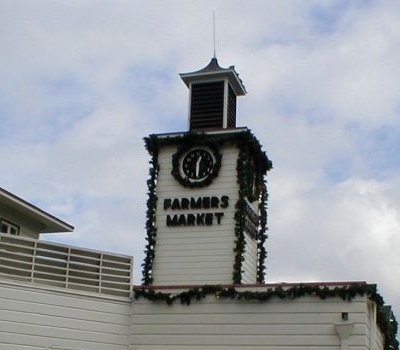 |
| The Grand Central Market has been doing business on the ground floor of the Homer Laughlin Building since 1917. This always bustling market is a favorite of tourists and locals alike. That's because the market which has remained unchanged has that historic flavor of a bygone era that's hard to find anywhere. There are vendors that sell everything from exotic fruits and spices to tea and fresh ground coffee from all over the world. There are also plenty of choices for breakfast, lunch and early dinner. Here's a historic note about the building: Architect Frank Lloyd Wright once had an office on an upper floor. Today the former office spaces above have been converted into upscale apartments. 317 S. Broadway a half block north of the Metro Rail Pershing Square subway station's 4th St. east exit. |
| When the stately Biltmore Hotel opened in 1923 with 1000 guest rooms in three towers, it was the largest hotel west of the Mississippi. Since then the Biltmore has continued a long standing tradition of greeting not only guests but also presidents, kings, heads of state, entertainers, movie stars, and the Beatles. During the 40's the Biltmore hosted several Academy Awards in the famous Biltmore Bowl. In 1960 the Biltmore was the headquarter hotel for the Democratic National Convention when John F. Kennedy was nominated for the presidency. The hotel is rich in art deco styling including the ceilings and murals which have been carefully restored and preserved in the lobby, ballrooms, and wide walkways. There's even the original and restored 1923 art deco indoor swimming pool on a lower level. Shops, fine restaurants and sports bars are located throughout this historic hotel. The Biltmore, now owned and operated by the prestigeous Millenium Hotels has always been and still is one of the premiere hotels in America. Within walking distance of the Jewelry and Financial Districts and a block west of the Pershing Square Metro Rail subway station. Website Biltmore Hotel |
| Disney Concert Hall is a world acclaimed landmark and home to the Los Angeles Philharmonic and Los Angeles Master Chorale. The auditorium has a seating capacity of 2,265. The exterior of the building is sheathed in stainless steel. On the roof top and hidden from view from the street is a wonderful garden complete with flowers, trees, a huge fountain, an amphitheatre and great views of the city. In 1987 Lillian Disney, widow of Walt Disney donated $50 million to begin the process of creating a world class concert hall in tribute to her late husband who enjoyed concerts by the Los Angeles Philharmonic and Los Angeles Master Chorale. World renouned Los Angeles based architect Frank Gehry was chosen to design the concert hall which is based on his Guggenheim museum design in Bilbao Spain. Sixteen years later Disney Concert Hall had a gala grand opening in October 2003. Two blocks west of the Civic Center Metro Rail subway station. Website Disney Concert Hall |
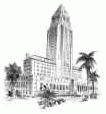 |
| LOS ANGELES ATTRACTIONS 3 |
| FROM LANDMARKS AND TOURIST ATTRACTIONS TO CULTURE AND THE ARTS |
 |
 |
| The Los Angeles Zoo encompasses 133 acres in Griffith Park. Each year over two million visitors view more than 1,200 animals from all over the world. The Los Angeles Zoo replaced the aging 1912 Griffith Park Zoo in 1966. Many remnants remain of the old zoo, a few miles south of the present day zoo. In November 1966 about 80,000 attended the Los Angeles Zoo's grand opening. Some of the animals that were at the zoo on opening day are still there including an an alligator named Methuselah. Today the Los Angeles Zoo has one of the world's most acclaimed animal collections including rare and endangered species such as the Sumatran rhino, yellow footed rock wallaby and the giant eland. On Zoo Drive in Griffith Park. Website Los Angeles Zoo |
| Dodger Stadium, home to the Los Angeles Dodgers first opened on April 10, 1962. The stadium located in Elysian Park seats 56,000 and sits on 300 acres of prime real estate just above Chinatown. Since opening day many historical events have taken place there over the decades including Sandy Koufax's four no hitters and perfect game, Pope John Paul II's Papal Mass on Sept. 16, 1987, concerts by the Beatles, Rolling Stones, Elton John, Bee Gees, David Bowie and others. One concert in particular took place in 1994 when internationally renowned tenors Jose Carreras, Placido Domingo and Luciano Pavarotti reunited for a spectacular performance "Encore - The Three Tenors" with conductor Zubin Mehta. Visitors to Elysian Park often pose for some great pictures with Dodger Stadium and the city skyline in the background. |
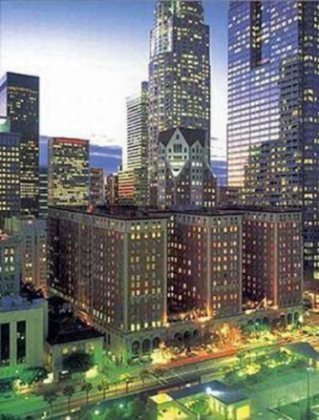 |
| Los Angeles's Chinatown has been around since the mid-1800s. It was originally located where the Los Angeles Union Passenger Terminal is today but when the train station was about to be built Chinatown was moved slightly West to it's present day location. A vibrant community, Chinatown is a city within the downtown City Center with tens-of-thousands of residents and hundreds of restaurants, shops and nightclubs. Great night life too. The landmark MTA Gold Line Metro station is a block east of Chinatown's business district. Website Los Angeles Chinatown |
| St. Vincent Court is a former alley-way that was transformed into a European street. Located in the heart of the Los Angeles Jewelry District, St. Vincent Court is a great place to get away from it all and rest those tired feet while having a quick lunch. Located on West 7th Street between Broadway and Hill Street. |
